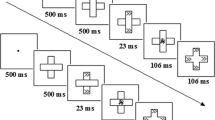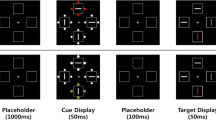Abstract
Selective attention has been viewed as a dualprocess mechanism, that is, exciting targets and inhibiting distractors. Most early studies concentrated mainly on the target-excitation, whereas recent investigations began to pay more attention to the inhibitory selective attention mechanism. A measure named negative priming (NP) was extensively employed to probe into the inhibitory processes. The Houghton and Tipper Model put forward a notion: the inhibition that feeds back to the distractor is reactive. That means, the level of inhibition is determined by the activation state of the distractor. Distractors that are more salient and intrude into the control of action receive greater inhibitory feedbacks than less salient distractors. Because increasing attention to an object would enhance the early processing of this object, we thus hypothesized that augmenting the level of attention to a distractor might lead to a higher level of inhibition, revealed as a corresponding augmentation in the magnitude of NP effect. To test this assumption, an objectbased identification task was then applied, and participants were asked to make the animate/inanimate categorization. Attention level was manipulated by varying the relative spatial locations of target and distractor (overlapped or separated). A reliable greater NP effect was found in the overlapped than separated condition, indicating that distractors under the high-level attention condition (overlapped) got greater initial excitation, and then evoked greater subsequent inhibitory feedbacks, therefore resulting in a larger NP effect. These results provide direct evidence for the reactive inhibition suggested by the Houghton and Tipper model. Meanwhile a coincident greater positive priming (PP) effect was obtained under the overlapped than separated condition, which could be attributed to the higher level of target activation in the overlapped condition. The covariation of NP and PP effects further confirmed that the way of our manipulation on attention level in this study was valid.
Similar content being viewed by others
References
Muller-Gass, A., Campbell, K., Event-related potential measures of the inhibition of information processing: I. Selective attention in the waking state, International Journal of Psychophysiology, 2002, 46: 177–195.
Slotnick, S. D., Schwarzbach, J., Yantis, S., Attentional inhibition of visual processing in human striate and extrastriate cortex, Neurolmage, 2003, 19: 1602–1611.
Marí-Beffa, P., Hayes, A. E., Machado, L. et al., Lack of inhibition in Parkinson’s disease: Evidence from a lexical decision task, Neuropsychologia, 2005, 43: 638–646.
Amso, D., Johnson, S. P., Selection and inhibition in infancy: Evidence from the spatial negative priming paradigm, Cognition, 2005, 95: B27-B36.
Tipper, S. P., Driver, J., Negative priming between pictures and words in a selective attention task: Evidence for semantic processing of ignored stimuli, Memory and Cognition, 1988, 16(1): 64–70.
Houghton, G., Tipper, S. P., Inhibitory mechanisms of neural and cognitive control: Applications to selective attention and sequential action, Brain and Cognition, 1996, 30: 20–43.
Tipper, S. P., Does negative priming reflect inhibitory mechanisms? A review and integration of conflicting views, The Quarterly Journal of Experimental Psychology, 2001, 54A(2): 321–343.
Houghton, G., Tipper, S. P., Weaver, B. et al., Inhibition and interference in selective attention: Some tests of a neural network model, Visual Cognition, 1996, 3(2): 119–164.
Neill, W. T., Valdes, L. A., Persistence of negative priming: steady state or decay, Journal of Experimental Psychology: Learning, Memory and Cognition, 1992, 18(3): 565–576.
Neill, W. T., Persistence of negative priming: II. Evidence for episodic trace retrieval, Journal of Experimental Psychology: Learning, Memory and Cognition, 1992, 18(5), 993–1000.
Neill, W. T., Episodic retrieval in negative priming and repetition priming, Journal of Experimental Psychology: Learning, Memory and Cognition, 1997, 23(6): 1291–1305.
Kane, M. J., May, C. P., Hasher, L. et al., Dual Mechanisms of Negative Priming, Journal of Experimental Psychology: Human Perception and Performance, 1997, 23(3): 632–650.
Park, J., Kanwisher, N., Negative priming for spatial locations: Identity mismatching, not distractor inhibition, Journal of Experimental Psychology: Human Perception and Performance, 1994, 20(3): 613–623.
Li, L., New views on the mechanism of negative priming, Psychological Science, 2001, 24(3): 330–333.
Yantis, S., Goal-directed and stimulus-driven determinants of attentional control. in Control of Cognitive Processes: Attention and Performance X VIII(eds. Monsell, S., Driver, J.), Cambridge: MIT Press, 2000, 73–103.
Metzler, C., Parkin, A. J., Reversed negative priming following frontal lobe lesions, Neuropsychologia, 2000, 38: 363–379.
Dimitrov, M., Nakic, M., Elpern-Waxman, J., Inhibitory attentional control in patients with frontal lobe damage, Brain and Cognition, 2003, 52: 258–270.
Park, S., Püschel, J., Sauter, B. H. et al., Spatial selective attention and inhibition in Schizophrenia patients during acute psychosis and at 4-month follow-up, Biological Psychiatry, 2002, 51: 498–506.
Fox, E., Fockert, J. W., Negative priming depends on prime-probe similarity: Evidence for episodic retrieval, Psychonomic Bulletin and Review, 1998, 5: 107–113.
Stolz, J. A., Healy, D., Taking a bright view of negative priming in the light of dim stimuli: Further evidence for memory confusion during episodic retrieval, Canadian Journal of Experimental Psychology, 2001, 55(3): 219–230.
MacDonald, P. A., Joordens, S., Seergobin, K. N., Negative priming effects that are bigger than a breadbox: Attending to distractors does not eliminate negative priming but rather enhances it, Memory and Cognition, 1999, 27: 197–207.
MacDonald, P. A., Joordens, S., Investigating a memory-based account of negative priming: Support for selection-feature mismatch, Journal of Experimental Psychology: Human Perception and Performance, 2000, 26(4): 1478–1496.
Facoetti, A., Molteni, M., Is attentional focusing an inhibitory process at distractor location? Cognitive Brain Research, 2000, 10: 185–188.
Gao, W. B., Wei, J. H., Peng, X. H. et al., Brain dynamic mechanisms on the visual attention scale with Chinese characters cues, Chinese Science Bulletin, 2002, 47(14): 1074–1078.
Gao, W. B., Wei, J. H., Peng, X. H. et al., The adjust mechanism of visual spatial attention scale on P2, Acta Psychologica Sinica, 2004, 36(2): 139–144.
Cutzu, F., Tsotsos, J. K., The selective tuning model of attention: Psychophysical evidence for a suppressive annulus around an attended item, Vision Research, 2003, 43: 205–219.
Müller, N. G., Mollenhauer, M., Rösler, A. et al., The attentional field has a Mexican hat distribution, Vision Research, 2005, 45: 1129–1137.
Orteils, J. J., Abad, M. J. F., Noguera, C. et al., Influence of prime-probe stimulus onset asynchrony and prime precuing manipulations on semantic priming effects with words in a lexical-decision task, Journal of Experimental Psychology: Human Perception and Performance, 2001, 27(1): 75–91.
Tipper, S. P., Meegan, D., Howard, L. A., Action-centred negative priming: Evidence for reactive inhibition, Visual Cognition, 2002, 9(4/5): 591–614.
Stablum, F., Ricci, R., Pavese, A. et al., Global / local processing and negative priming: The influence of selection difficulty and stimulus exposure, Psychological Research, 2001, 65: 81–97.
Hibi, Y., Takeda, Y., Yagi, A., Attention level and negative priming in hierarchical patterns, Japanese Psychological Research, 2002, 44(4): 241–246.
Orteils, J. J., Tudela, P., Positive and negative semantic priming of attended and unattended parafoveal words in a lexical decision task, Acta Psychologica, 1996, 94: 209–226.
Author information
Authors and Affiliations
Corresponding author
About this article
Cite this article
Geng, H., Song, Q., Li, Y. et al. The effect of attention to distractor on inhibitory processes in selective attention. Chin.Sci.Bull. 50, 1743–1750 (2005). https://doi.org/10.1360/982005-516
Received:
Accepted:
Issue Date:
DOI: https://doi.org/10.1360/982005-516




